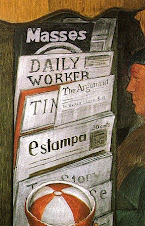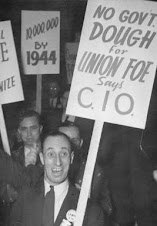
By Fred Goldstein
Published Aug 8, 2010 11:43 PM
Corporate profits are rising, corporate cash is piling up, business has increased. But jobs are not coming back any time soon for the millions of unemployed.
This is the theme running through the big business media. It shows deep anxiety over the new stage of the capitalist economy and the way the “jobless recovery” is playing out.
While 30 million workers remain unemployed or underemployed, corporate profits have soared to an annual rate of $1.2 trillion — higher than at the height of the bubble. Much of that $1.2 trillion comes from laying off workers and getting more production out of those who remain.
“It turns out,” wrote Steven Pearlstein in the July 30 Washington Post, “that companies have found ways to produce as much as they ever did, but with fewer workers. As a result, over the past year, output for each hour worked rose more than 6 percent, even as average hourly earnings have risen less than 2 percent. The rest of those productivity gains have gone straight to the bottom line, creating a record stash of cash on corporate balance sheets.
“Some of the cash,” continued the article, “has been used to pay down debt or buy back stock. But so far the one thing businesses haven’t done is hire back full-time employees, preferring instead to contract for temporary workers or increase the hours of the workers they already have.”
Pearlstein then made a remarkably candid observation for the big business press: “The only surprise is that anyone is surprised by the lack of private-sector hiring. It is only in the world of Chamber of Commerce propaganda that businesses exist to create jobs. In the real world, businesses exist to create profits for shareholders, not jobs for workers. That’s why they call it capitalism, not job-ism.”
When a mouthpiece of big business such as the Washington Post allows such anti-capitalist commentary, it is a sign of deep worry about the permanence of this economic system.
The July 26 New York Times described the same trend in a piece entitled “U.S. Firms Wringing Huge Profits Out of Job Cuts.” The headline says it all.
The Times chose to focus on Harley-Davidson, whose sales have fallen for the last three years in a row. “But despite that drought,” observed the Times, “Harley’s profits are rising — soaring, in fact. Last week, Harley reported a $71 million profit in the second quarter, more than triple what it earned a year ago.
“This seeming contradiction — falling sales and rising profits — is one reason the mood on Wall Street is so much more buoyant than in households, where pessimism runs deep and joblessness shows few signs of easing.”
A future of economic contraction & layoffs
The Times points to the fact that Harley has laid off 2,000 workers — a fifth of its workforce — and is planning to terminate 1,400 to 1,600 more by the end of next year. Harley has warned union employees at its Milwaukee factory that it would move production elsewhere in the United States if they did not agree to more flexible work rules and tens of millions in cost-saving measures.
Harley’s evolution is part of a longer-term shift in U.S. manufacturing, said Rod Lache, an analyst with Deutsche Bank, in the Times article. “These companies have cracked the code of a successful industrial turnaround. They’re shrinking the business to a size that’s defendable, and growing off that lower base.”
On a larger scale, the Times article continues, Ford’s revenue is down $20 billion since 2005. But this year, instead of a loss, it expects to announce a $5 billion profit in large part because “Ford has shrunk its North American workforce by nearly 50 percent over the last five years.”
“When Alcoa reported a turnaround this month in profits and a 22 percent jump in revenue,” adds the Times, “its chief financial officer, Charles D. McLane Jr., assured investors that it was not eager to recall the 37,000 workers let go since late 2008. ‘We have a tight focus on spending as market activity increases, operating more effectively and minimizing rehires where possible,’ he said. ‘We’re not only holding headcount levels, but are also driving restructuring this quarter that will result in further reductions.’”
A spokesperson for Alcoa said the company “had to be resized to match the realities of the recession.”
Whole industries are making more profits than ever on lower sales. Lower sales reflect lower production. Lower production reflects lower employment. And this is a permanent condition arising out of the present economic crisis.
First-time unemployment claims & the ‘recovery’
Since the end of 2007 these bosses have laid off more than 8 million workers in the worst economic crisis since the Great Depression. That was on top of the 7 million already unemployed before the crisis hit. Millions of others have been put on short hours, have suffered mandatory furloughs, or have been forced to work at reduced wages with harsh conditions and speed-up.
It is estimated that 150,000 new jobs are needed each month just to hire young people who come of working age. Now many of these youth cannot get any connection to the job market and do not even appear in the statistics.
Most of the layoffs that have taken place are permanent. Jobs are not coming back, even though we are now officially in the fourth quarter of a “recovery.”
First-time jobless filings have remained in the range of at least 450,000 per month during the entire eight months of the “recovery.” This has been described as “eight months of going sideways.” The most recent first-time claims for unemployment went down by a four-week average of 4,500. That decline represents a drop of only 1 percent, which is both statistically and humanly irrelevant for the nearly half a million workers who did file.
What kind of “recovery” is it when official unemployment remains at 9.5 percent?
There is no mystery about the unemployment crisis. The capitalists caused it. And now these millionaires and billionaires are hanging on to their profits and their cash reserves for dear life rather than relieve the mass suffering they have caused.
Nonfinancial companies are sitting on $1.8 trillion in cash reserves, roughly one-quarter more than at the beginning of the recession. Yet they won’t rehire full-time workers in any significant numbers, despite the desperate job crisis. People are losing their homes, living out of their cars, doubling and tripling up with relatives, losing their health insurance and their human dignity, while the moneybags who run the profit system find ways to cut more workers.
A Marxist approach to crisis
Marxists have both an analysis of the crisis and a strategy for fighting back.
From the standpoint of analysis, it is clear that capitalism itself is at an impasse. The system cannot start itself up again, and has reached an historical crisis point. All the technology, all the speed-up, the great rise in productivity — another name for a great increase in the rate of exploitation of the working class — has brought the contradictions of capitalism to a new level.
Workers to live under capitalism must have jobs. For workers to have jobs, production must constantly expand. For production to expand, there must be expanding markets so the capitalists can sell at a profit. But the bosses are boosting their profits by driving down wages, laying off workers permanently and cutting hours. In doing so, they destroy the buying power, the consumption of the workers.
The present crisis with its “jobless recovery” shows that capitalism has only misery in store for the working class, and especially African-American, Latino/a, undocumented immigrants, youth, women and all other oppressed workers who suffer higher rates of unemployment and get lower wages. The capitalists have been putting in job-destroying technology for three decades until it has reached a turning point: The system is now so productive they have to shrink production in order to stay profitable.
This is the vicious capitalist cycle, which only gets worse as the system goes on.
Demand a new WPA-style jobs program
While that is a Marxist analysis of the situation, the Marxist fighting response is that the bosses are on a hiring strike. And the workers have to fight to get jobs any way they can. They must fight to reopen closed workplaces. They must fight to rehire laid-off workers. And they must establish that they have the right to a job. There is no other way for workers to live under capitalism — the right to a job reduces itself to the right to live.
The bosses have $1.8 trillion in cash that they can use to start rehiring — if they are forced to do so by a mass mobilization of the working class and the communities around the country.
But in addition to these direct battles with the bosses, the capitalist government must be forced to give every worker who needs one a job at living wages with benefits. In the Depression of the 1930s, the Roosevelt administration, under pressure of mass demonstrations, was forced to launch the Works Progress Administration. It provided 8 million workers with jobs at prevailing wages.
The question of jobs is becoming a political issue seized on by the right wing to attack undocumented workers and even the Obama administration. This campaign is intended to divide the working class and poison the atmosphere with racism in order to keep the workers from uniting against their real enemy: the bosses and bankers who are ruthlessly throwing them onto the unemployment lines and out of their homes.
The right-wing attack does not include the demand for a jobs program for all. But the workers’ movement, the union movement and all the mass organizations should come together with a practical program to take the trillions of dollars in the vaults of the banks and corporations, the hundreds of billions of dollars given to the Pentagon, and the trillions in tax breaks for the rich and use it to put workers back to work.
The Obama administration has given the banks and corporations many concessions and bailouts, but it is not responsible for the economic crisis. It is capitalism itself and the profit-seeking capitalist class that is responsible.
This tiny handful of billionaires owns and controls the economy and the vast wealth created by the working class. They run the global system of production for profit. The economy must ultimately be taken out of their hands and put in the hands of the workers so that production can be planned to meet the needs of the many, not the profits of the few.
Goldstein is author of the book “Low-Wage Capitalism,” a Marxist analysis of globalization and its effects on the U.S. working class. He has also written numerous articles and spoken on the present economic crisis. For further information visit www.lowwagecapitalism.com.
Articles copyright 1995-2010 Workers World. Verbatim copying and distribution of this entire article is permitted in any medium without royalty provided this notice is preserved.










































No comments:
Post a Comment